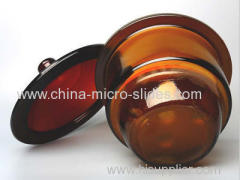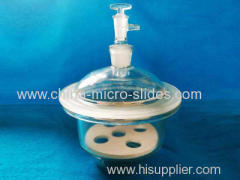




Desiccator With Grounded Cover
| Min. Order: | 1000 Piece/Pieces |
|---|---|
| Trade Term: | FOB,CFR |
| Payment Terms: | L/C, T/T |
| Supply Ability: | 100million |
| Place of Origin: | Zhejiang |
Company Profile
| Location: | Ningbo, Zhejiang, China (Mainland) |
|---|---|
| Business Type: | Manufacturer |
Product Detail
| Means of Transport: | Express, Ocean, Air |
|---|---|
| Material: | Glass |
| Apply: | School,Laboratory,Clinic |
| Certificate: | CE,ISO9001:2000,ISO13485 |
| Export Area: | Global |
| Production Capacity: | 100million |
| Packing: | Carton |
| Delivery Date: | 20days |
Product Description

The desiccator is a sealed container with a wide-edged grounded cover. The lower half of the base is a narrow waist, and there is a wide edge on the inner wall of the waist, which is used to place the porcelain plate. Porcelain plate has holes of different sizes. Dry substances are stored on the top of the plate, and drying agents are stored on the bottom of the plate. The cover is arched and has a round glass drop on the top, which is used as a handle to move the cover. The wide edge of the cover is ground flat and matches with the base to achieve the purpose of sealing.In addition to the above shapes, the vacuum desiccator is different in that there is a hole in the top of the lid with a flange opening and a branch pipe. A vacuum piston with a bent hook at the lower end runs into each other, and the branch of the piston is connected to a mechanical pump or a suction pipe for vacuum pumping. Bending hook is convenient for hanging dry material.
Usage:
1.Wash and dry the desiccator, put different drying agents into the base of the desiccator as needed (usually with discolored silica gel, concentrated sulphuric a-cid or anhydrous calcium chloride, etc.), then put on the porcelain plate, and place the drying materials on the porcelain plate (if the medium-heat material is put in, move the desiccator cover from time to time, let the air out, otherwise it will be heated and swelled by air. Bulge up the lid). Then apply a layer of Vaseline grease on the wide edge of the desiccator. Cover the lid and rub it along the horizontal direction several times to make the grease uniform. Then the desiccator can be dried. When opening the desiccator cover, one hand holds the desiccator, the other hand moves the desiccator cover along the horizontal direction to open it. Otherwise, pull it up hard. On the one hand, it is difficult to open it with too much force. On the other hand, it often brings the base up with too much force, in case of falling off, the instrument will be damaged.
2.Before using the vacuum desiccator a layer of vacuum piston grease should be coated on the wide edge of the desiccator and the vacuum piston. After uniform friction, the vacuum test is carried out. If the instrument is in good condition, the lid can be opened to place the dry material on the porcelain plate or hang on the vacuum piston hook, cover the lid, and then open the piston for vacuum pumping. When the vacuum degree reaches the need, the mechanical pump can stop closing the piston, which can play the role of drying. To open the vacuum desiccator, first open the vacuum piston and put it into the air, then open it according to the ordinary drying method.
3.Vacuum desiccator is suitable for laboratories of petrochemical industry, pharmaceutical industry, medical and health, iron and steel metallurgy, industrial and mining enterprises and scientific research institutes. It can be used as a container for drying and preservation of deliquescent deteriorating reagents, drug-s, precision metal components, cameras, microscopic lenses and glass instruments requiring constant weight for laboratory use.In addition to the above uses, vacuum desiccator can not use desiccant for drying some substances. It can only use vacuum dehydration method to remove moisture from substances. For example, using desiccant and vacuum at the same time can improve drying speed and efficiency.
Attention:
1. Do not put too much desiccant in order to avoid contaminating the bottom of the desiccator.
2. When moving the desiccator, hold it with both hands and press the lid tightly with your thumb.
3. When opening the desiccator, do not lift the lid upward. Hold the desiccator with your left hand. Carefully push the lid away with your right hand. After the cold air slowly enters, the lid can be pushed open. The lid must be placed on the table.
4. Do not put too hot objects into the desiccator.
5. Sometimes when a hot object is put into a desiccator, the air expands when heated, and the lid will be lifted up. In order to prevent the lid from being overturned, the lid should be held by hand and slightly pushed open from time to time.
6. The precipitation after burning or drying should not be placed too long in the desiccator, otherwise the quality will be slightly increased due to the absorption of some moisture.
7. The discolored silica gel is blue when dried and pink when damped. It can be used repeatedly after the silica gel is dried at 120℃ and becomes blue until it is broken and unusable.
Glass: clear glass, amber glass
Vacuum: with vacuum,w/o vacuum
Cat. No. | I.D.(mm) | Overall Height(mm) | Porcelain Plate Dim.(mm) | Packing |
Clear glass, with porcelain plate(amber glass optional) | ||||
DP150 | 150 | 220 | 135 | 2pcs/carton |
DP180 | 180 | 280 | 150 | 2pcs/carton |
DP210 | 210 | 320 | 185 | 1pcs/carton |
DP240 | 240 | 360 | 210 | 1pcs/carton |
DP300 | 300 | 365 | 275 | 1pcs/carton |
DP350 | 350 | 405 | 315 | 1pcs/carton |
DP400 | 400 | 470 | 355 | 1pcs/carton |
Vacuum, clear glass, with porcelain plate(amber glass optional) | ||||
DPV150 | 150 | 220 | 135 | 2pcs/carton |
DPV180 | 180 | 280 | 150 | 2pcs/carton |
DPV210 | 210 | 320 | 185 | 1pcs/carton |
DPV240 | 240 | 360 | 210 | 1pcs/carton |
DPV300 | 300 | 365 | 275 | 1pcs/carton |
DPV350 | 350 | 405 | 315 | 1pcs/carton |
DPV400 | 400 | 470 | 355 | 1pcs/carton |



